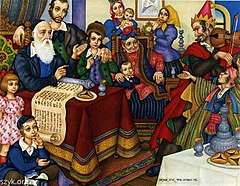
Back Poerim Afrikaans Purim ALS عيد المساخر Arabic عيد الفور ARZ پوریم AZB Пурим Bashkir Пурым Byelorussian Пурим Bulgarian Pourim Breton Purim Catalan
| Purim | |
|---|---|
 Purim by Arthur Szyk | |
| Type | Jewish |
| Significance | Celebration of Jewish deliverance as told in the Book of Esther (megillah) |
| Celebrations |
|
| Date | 14th day of Adar (in Jerusalem and all ancient walled cities, 15th of Adar) |
| 2023 date | Sunset, 6 March – nightfall, 7 March |
| 2024 date | Sunset, 23 March – nightfall, 24 March |
| 2025 date | Sunset, 13 March – nightfall, 14 March |
| 2026 date | Sunset, 2 March – nightfall, 3 March |
| Frequency | Annual |
| Started by | Esther |
| Related to | Hanukkah, as a rabbinically decreed Jewish holiday |
| Part of a series on |
| Jews and Judaism |
|---|
Purim (/ˈpʊərɪm/;[1] פּוּרִים , lit. 'lots'; see Name below) is a Jewish holiday that commemorates the saving of the Jewish people from annihilation at the hands of an official of the Achaemenid Empire named Haman, as it is recounted in the Book of Esther (usually dated to the late-5th or 4th centuries BCE).[2]
Haman was the royal vizier to the Persian king Ahasuerus (Xerxes I or Artaxerxes I; Khshayarsha and Artakhsher in Old Persian, respectively).[3][4][5][6] His plans were foiled by Mordecai of the tribe of Benjamin, and Esther, Mordecai's cousin and adopted daughter who had become queen of Persia after her marriage to Ahasuerus.[7] The day of deliverance became a day of feasting and rejoicing among Jews.
According to the Scroll of Esther,[8] "they should make them days of feasting and gladness, and of sending portions one to another, and gifts to the poor". Purim is celebrated among Jews by:
- Exchanging gifts of food and drink, known as mishloach manot.
- Donating charity to the poor, known as mattanot la-evyonim.[9]
- Eating a celebratory meal with alcoholic beverages, known as se'udat Purim or "Mishteh".
- Public recitation of the Scroll of Esther (קריאת מגילת אסתר), or "reading of the Megillah", usually in synagogue.
- Reciting additions to the daily prayers and the grace after meals, known as Al HaNissim.
- Applying henna[10][11] (Sephardic and Mizrahi Jews).
Other customs include wearing masks and costumes, public celebrations and parades (Adloyada), eating hamantashen (transl. "Haman's ears"), and drinking wine.[12]
According to the Hebrew calendar, Purim is celebrated annually on the 14th day of the Hebrew month of Adar (and it is celebrated in Adar II in Hebrew leap years, which occur 7 times in every 19 years), the day following the victory of the Jews over their enemies, the 13th of Adar, a date now observed in most years with the fast of Esther.
In cities that were protected by a surrounding wall at the time of Joshua, Purim is celebrated on the 15th of the month of Adar on what is known as Shushan Purim, since fighting in the walled city of Shushan continued through the 14th day of Adar.[13] Today, only in Jerusalem Purim is observed on the 15th, and in several other biblical settlements (such as Hebron and Shilo) it is celebrated on both dates because of doubts regarding their status as cities surrounded by a wall since the days of Joshua.
- ^ "Purim". Oxford English Dictionary (Online ed.). Oxford University Press. Retrieved 30 September 2024. (Subscription or participating institution membership required.)
- ^ Miller, Tricia (2015). Jews and Anti-Judaism in Esther and the Church. James Clarke & Company Limited. p. 15. ISBN 978-0-227-90252-3.
- ^
 Singer, Isidore; et al., eds. (1906). "Ahasuers". The Jewish Encyclopedia. New York: Funk & Wagnalls. Archived from the original on 3 July 2014.
Singer, Isidore; et al., eds. (1906). "Ahasuers". The Jewish Encyclopedia. New York: Funk & Wagnalls. Archived from the original on 3 July 2014.
- ^ Encyclopædia Perthensis, Or, Universal Dictionary of the Arts, Sciences, Literature etc. Vol. 9. Edinburgh: John Brown, Anchor Close (Printers). 1816. p. 82. Archived from the original on 17 October 2015.
- ^ Law, George R. (2010). Identification of Darius the Mede. Ready Scribe Press. pp. 94–96. ISBN 978-0982763100. Archived from the original on 17 October 2015.
- ^ First, Mitchell (2015). Esther Unmasked: Solving Eleven Mysteries of the Jewish Holidays and Liturgy. Kodesh Press. p. 163. ISBN 9780692375426. Archived from the original on 10 July 2024. Retrieved 12 March 2023.
- ^ "Esther 2 / Hebrew – English Bible". Mechon-Mamre. Archived from the original on 9 March 2021. Retrieved 9 March 2020.
- ^ Esther 9:22
- ^ Barclay, Elozor; Yitzchok Jaeger (27 January 2004). "Gifts to the Poor". Aish.com. Archived from the original on 27 April 2014. Retrieved 12 March 2014.
- ^ Monger, George (23 November 2004). Marriage Customs of the World: From Henna to Honeymoons. Bloomsbury Academic. ISBN 978-1-57607-987-4. Archived from the original on 24 March 2023. Retrieved 18 February 2024.
- ^ "The Henna Page - Henna Traditions of Purim in Kurdistan". www.hennapage.com. Archived from the original on 21 February 2024. Retrieved 12 February 2024.
- ^ "Purim 2012 Guide". Chabad-Lubavitch Media Center. Archived from the original on 7 April 2012. Retrieved 5 March 2012.
- ^ Shulchan Aruch Orach Chayyim 685:1